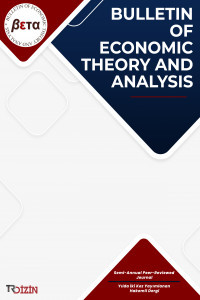The Macro-Prudential Measures Taken in Turkey Following the 2008-2009 Global Financial Crisis
Bu çalışmanın amacı, Türkiye'de 2010-2015 yılları arasında alınan makro-ihtiyati tedbirleri bütüncül ve sistematik bir çerçevede incelemek, ihtiyati politika araçlarının ne ölçüde kullanıldığını göstermek ve Türkiye'de uygulamaya koyulan Basel III standartlarını açıklamaktır. Bu anlamda, bildiğimiz kadarıyla, bu çalışma 2010-2015 döneminde Türkiye'de alınan makro ihtiyati tedbirlerin tamamını ele alan ilk ve en kapsamlı çalışmadır. Bu çalışma yapılırken finansal istikrara ve makro-ihtiyati tedbirlere ilişkin tüm ilgili mevzuat ve raporlar incelenmiş ve kullanılan makro-ihtiyati politika araçları, krediyle ilgili, likiditeyle ilgili ve sermaye ile ilgili tedbirlerden oluşan bir çerçeve içerisinde değerlendirilmiştir. Ayrıca, çalışmanın analiz kapsamını genişletmek için literatürdeki mevcut çerçeveye Basel III standartları da dahil edilmiştir. Çalışma kapsamındaki dönemde, Türkiye’de döviz cinsi kredileri kısıtlama, net açık döviz pozisyonunu kısıtlama ve para birimi uyumsuzluklarını kısıtlama hariç olmak üzere tüm araçlar kullanılmıştır. 2010-2015 yılları arasında politika yapıcı kurumlar tarafından toplam 93 düzenleme uygulamaya konmuştur. Makro-ihtiyati tedbirlerin en yoğun şekilde kullanıldığı yıllar sırasıyla 2013, 2011 ve 2015’tir.
Anahtar Kelimeler:
Küresel Finansal Kriz, Finansal İstikrar, Makro İhtiyati Politikalar, Basel III
The Macro-Prudential Measures Taken in Turkey Following the 2008-2009 Global Financial Crisis
The objective of this study is to examine the macro-prudential measures that were taken in Turkey between 2010 and 2015 within a holistic, and, an organized framework, to demonstrate the extent to which the prudential policy tools were used, and, to explain which Basel III standards were adopted in Turkey. In this sense, to our knowledge, this is the first and the most comprehensive study that deals with the macro-prudential measures in Turkey during the period 2010-2015. We reviewed all relevant legislation and reports regarding financial stability and macro-prudential measures. Then, we fit all macro-prudential policy tools into a framework which consists of loan-related measures, liquidity-related measures, and, capital-related measures. Furthermore, we incorporated Basel III standards with our framework in order to expand the scope of our analysis. Within the period under consideration, Turkey utilized all of the tools, except the limit on foreign currency lending, the limit on net open foreign currency position, the limit on currency mismatches. The authorities put 93 regulations into practice in total. 2013, 2011 and 2015 were the years in which the regulations were issued most extensively.
___
- Alper, K., Kara, H. & Yörükoğlu, M. (2012). “Reserve options mechanism”, Central Bank of Turkey Research Notes in Economics, No: 12/28. Alınan yer http://tcmb.gov.tr/wps/wcm/connect/2b1d1e59-28b4-4025-9504-4e9bfee917d3/EN1228eng.pdf?MOD=AJPERES&CACHEID=ROOTWORKSPACE2b1d1e59-28b4-4025-9504-4e9bfee917d3.
- Bank of England (2011). “Instruments of macroprudential policy”, Discussion Paper. Alınan yer http://www.bankofengland.co.uk/publications/Documents/other/financialstability/ discussionpaper111220.pdf.
- Banking Regulation and Supervision Agency (BRSA) (2012). Annual Report 2011, Ankara.
- ____________________________________________ (2014). Annual Report 2013, Ankara.
- ____________________________________________ (2015). Annual Report 2014, Ankara.
- ____________________________________________(2016). Annual Report 2015, Ankara.
- Bank of International Settlements (BIS) (2010). Guidance for National Authorities Operating the Countercyclical Capital Buffer. Alınan yer http://www.bis.org/publ/bcbs187.pdf.
- _________________________________ (2011). Basel III: A Global Regulatory Framework for More Resilient Banks and Banking Systems. Alınan yer http://www.bis.org/publ/bcbs189.pdf.
- _________________________________ (2014). Basel III: The Net Stable Funding Ratio. Alınan yer http://www.bis.org/bcbs/publ/d295.pdf.
- Blanchard, O., Dell’Ariccia, G. & Mauro, P. (2010). “Rethinking Macroeconomic Policy,” Journal of Money, Credit, and Banking, 42 (Supplement), 199–215. Alınan yer Econpapers.
- Caruana, J. (2010). Macroprudential Policy: Working towards a New Consensus. Remarks at the high-level meeting on “The Emerging Framework for Financial Regulation and Monetary Policy” jointly organised by the BIS’s Financial Stability Institute and the IMF Institute, Washington DC. Alınan yer http://www.bis.org/speeches/sp100426.pdf.
- Galati, G. & Moessner, R. (2011). “Macroprudential Policy – A Literature Review”, BIS Working Papers, No. 337. Alınan yer http://www.bis.org/publ/work337.pdf.
- Hellwig, M. (2014). Systemic-risk and Macro-prudential Policy. In A. Houben, R. Nijskens & M. Teunissen (Eds.), Putting Macroprudential Policy to Work (pp. 42-77). Amsterdam: De Nederlandsche Bank.
- Lim, C., Columba, F., Costa, A., Kongsamut, P., Otani, A., Saiyid, M., … Wu, X. (2011). “Macroprudential Policy: What Instruments and How to Use Them: Lessons from Country Experiences”, International Monetary Fund Working Papers, (WP/11/238). Alınan yer http://www.imf.org/external/pubs/ft/wp/2011/wp11238.pdf.
- Özatay, F. (2013). Monetary economics: Theory and policy [Turkish]. Ankara: Efil.
- Central Bank of the Republic of Turkey (CBRT) (2009); Monetary and Exchange Rate Policy Report 2010, Ankara.
- ______________________________________ (2010). Monetary Policy Exit Strategy, Ankara.
- ______________________________________ (2011a). Financial Stability Report, No. 12 (May), Ankara.
- ______________________________________ (2011b). Financial Stability Report, No. 13 (November), Ankara.
- ______________________________________ (2013a). Financial Stability Report, No. 16 (May), Ankara.
- ______________________________________ (2013b). Financial Stability Report, No. 17 (November), Ankara.
- ______________________________________ (2014a). Financial Stability Report, No. 18 (May), Ankara.
- ______________________________________ (2014b). Financial Stability Report, No. 19 (November), Ankara, 2014b.
- ______________________________________ (2015). Financial Stability Report, No. 21 (November), Ankara.
- ______________________________________ (2016). Annual Report 2015, Ankara.
- Vural, U. (2013). “Rise of the Non-traditional Monetary Policies”[Turkish], Unpublished proficiency dissertation submitted to the Central Bank of the Republic of Turkey. Alınan yer http://tcmb.gov.tr/wps/wcm/connect/b5c5e45f-7cf1-47e2-966d-4b4e6d7d60a7/umutvural.pdf?MOD=AJPERES&CACHEID=ROOTWORKSPACEb5c5e45f-7cf1-47e2-966d-4b4e6d7d60a7.
- Yayın Aralığı: Yılda 2 Sayı
- Başlangıç: 2016
- Yayıncı: Mehmet SONGUR
